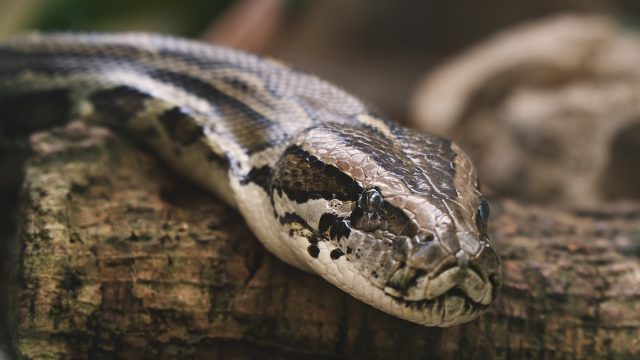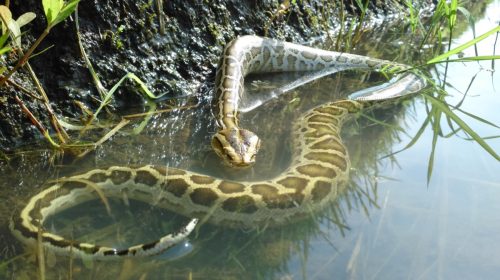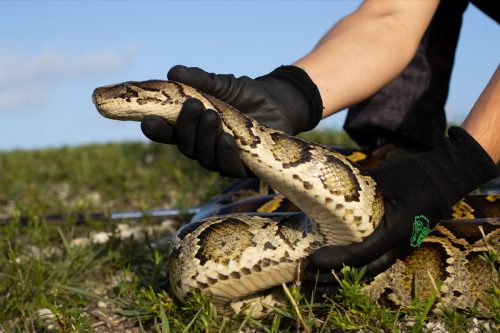Giant Invasive Pythons Are Moving North and "Need an Army" to Be Stopped
Experts say this non-native snake species is threatening ecosystems as its spreads.

From rattlesnakes and copperheads to cottonmouths and coral snakes, the U.S. is home to dozens of different snake species. And if that isn't scary enough for those of us who prefer to steer clear of these critters, a non-native snake is now causing serious concern for locals and scientists. Giant invasive pythons have been found in Southern Florida, and experts are acknowledging that they're struggling to keep the snakes from spreading even further. Read on to find out why these pythons "need an army" to be stopped.
RELATED: Giraffe-Sized Python Found in the U.S.—Why They're Unstoppable.
Burmese pythons have been breeding in Florida since at least 2000.

The invasive Burmese python has made itself a home across the bottom half of Florida. Back in February, scientists from the U.S. Geological Survey (USGS) released a report about the development of these snakes in the southern part of the state. According to the report, the first findings of Burmese pythons in Everglades National Park date back all the way to the late '70s. But scientists officially confirmed that the species had established a reproducing population there in 2000.
"The population has since expanded and now occupies much of southern Florida," the USGS stated in a press release accompanying the report. "They consume a wide range of animals and have altered the food web and ecosystems across the Greater Everglades."
RELATED: 20 Rattlesnakes Found in Man's Garage—Here's Where They Were Hiding.
Experts say these pythons have started to move north.

This invasive species has already started pushing past southern Florida. Ian Bartoszek, a biologist with the Conservancy of Southwest Florida, told Insider in September that scientists are seeing Burmese pythons "show up in counties further and further to the north" every year. It's unclear just how far they've spread, but current research indicates that the snakes reached at least as far as Lake Okeechobee, which is near West Palm Beach.
Nick Ziegler, a 23-year-old Florida Atlantic University student who is contracted by the Florida Fish and Wildlife Conservation Commission (FWC) to remove Burmese pythons from the Everglades, recently confirmed that he has noticed the upward mobility of this species over the past few years, The Palm Beach Post reported.
"I used to go down south to catch pythons, but I've been catching them up north. I caught my first python in Palm Beach County over winter break," Ziegler told the newspaper.
RELATED: 8 Things in Your Yard That Are Attracting Snakes to Your Home.
These large snakes are altering ecosystems.

The Burmese python is one of the largest snakes in the world—with the biggest Burmese captured in Florida so far measuring over 18 feet in length, according to the FWC. Due to their large size and wide-ranging diet, these snakes have no real predators. Consequently, they have altered the ecosystem in southern Florida by preying on different native species and reducing their populations.
"I remember the Everglades as being this wildlife wonderland," Toby Benoit, a python hunter in Florida told The Palm Beach Post. "There were just herds of deer. You could go down to the levees, and you'd see bobcats, possums, raccoons, and birds like out of a National Geographic study of Africa. It was just amazing."
But the Everglades has turned into a "ghost town" since the invasion of Burmese pythons, according to Benoit, who was just one of the participants in the 10-day 2023 Florida Python Challenge this August. This annual competition was created by the FWS to increase awareness of invasive pythons and their negative impaction Florida's ecology by enlisting regular people to help capture and remove Burmese snakes.
Some say the pythons "need an army" to be stopped.

Python hunting is no easy job, however. After five years of participation, Benoit told The Palm Beach Post that he realized just how quickly these Burmese pythons can adapt to their surrounding environment.
"I think the best advice I received was don't focus on looking at everything to be a snake; start focusing on everything that doesn't look like a snake," he said. "They have the greatest camouflage pattern in all of nature."
During the 2023 Florida Python Challenge, around 230 pythons were captured by competitors, according to the newspaper. And these aren't the only eradication efforts being made. Scientists like Bartoszek have also been working on using radio telemetry to track pythons, and he and his team have caught a record number of pythons this season, according to The Palm Beach Post.
"We're nearing the end of this season, and we're close to 5,000 pounds pulled out since November," Bartoszek said.
But while any contribution to the remove effort is appreciated, controlling the snake population and stopping its spread remains a massive challenge.
"There needs to be bigger picture landscape-level tools developed to address the problem," he told The Palm Beach Post. "This issue isn't going away, and we need an army of observers out there.
RELATED: For more up-to-date information, sign up for our daily newsletter.





















